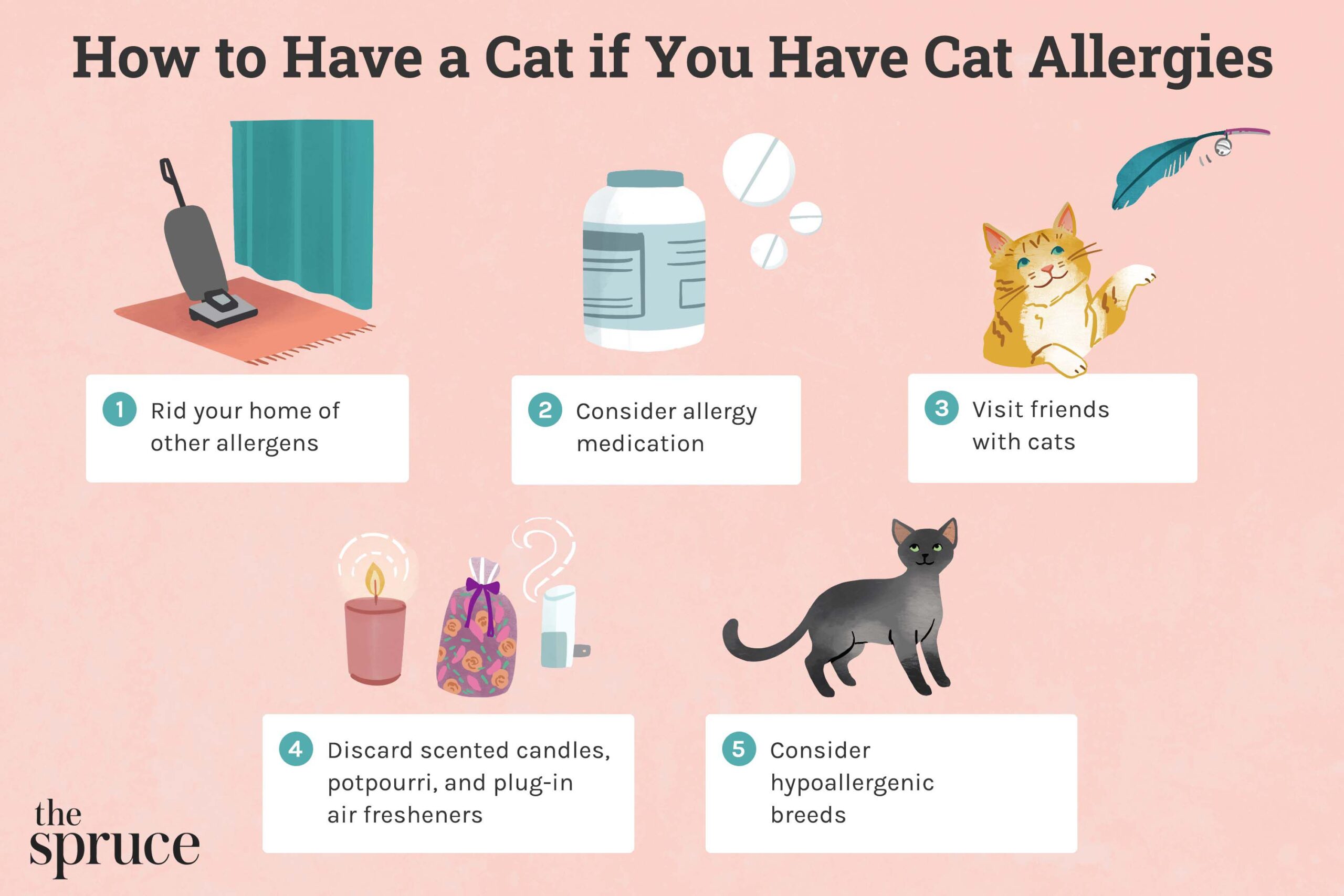Reduce exposure to cat allergens by keeping cats out of bedrooms. Use HEPA filters and clean frequently to minimize allergens.
What can I Give me cat if it is affected by any cat allergies
Cat allergies can be challenging, but there are effective ways to manage them. People with cat allergies react to proteins found in a cat’s skin cells, urine, and saliva. Symptoms can include sneezing, runny nose, itchy eyes, and skin rashes.
Creating a cat-free zone in your home, such as the bedroom, can greatly reduce allergen exposure. Regular cleaning, including vacuuming with a HEPA filter and washing cat bedding, helps keep allergens at bay. Consulting with an allergist can provide additional strategies and treatments. With a few adjustments, it is possible to coexist with a cat while minimizing allergy symptoms.
Identifying Cat Allergies
Cat allergies can be challenging for pet lovers. Knowing the signs and getting a proper diagnosis is key. Let’s explore how to identify cat allergies effectively.
Recognizing Common Symptoms
Common symptoms of cat allergies vary. Here are some key signs:
- Itchy eyes: Your eyes may feel itchy and watery.
- Sneezing: Frequent sneezing is a common symptom.
- Runny or stuffy nose: You may notice nasal congestion.
- Skin rashes: Red, itchy skin can appear after contact with a cat.
- Wheezing: Breathing may become difficult, and you might wheeze.
Recognizing these symptoms early helps in managing allergies better.
Seeking Medical Confirmation
Consulting a doctor is crucial for a proper diagnosis. Medical tests can confirm cat allergies:
| Test | Description |
|---|---|
| Skin prick test | Doctors place a tiny amount of allergen on your skin. They then prick the skin to introduce the allergen. If you’re allergic, a small bump will appear. |
| Blood test | Doctors take a blood sample to measure your immune system’s response to cats. This can help confirm an allergy. |
Getting medical confirmation helps in planning effective allergy management strategies.

Credit: be.chewy.com
Understanding Allergen Sources
Dealing with cat allergies can be challenging. Understanding allergen sources is crucial. This helps in managing symptoms effectively. Knowing where allergens come from makes it easier to reduce them.
Culprits Behind The Sneezes
Allergens can come from various sources. The main culprits are:
- Cat dander: Tiny flakes of skin shed by cats.
- Saliva: Cats groom themselves, spreading saliva on their fur.
- Urine: Contains proteins that can trigger allergies.
These allergens are microscopic. They can easily spread throughout your home. Reducing these sources is key to managing allergies.
How Cats Spread Allergens
Cats spread allergens in different ways. Here are the most common methods:
- Grooming: Cats lick their fur, spreading saliva allergens.
- Shedding: Fur and dander fall off as cats move around.
- Using the litter box: Urine allergens become airborne.
Allergens can stick to surfaces like furniture and carpets. Regular cleaning helps reduce allergen levels. Keeping your cat groomed also helps.
| Allergen Source | Spread Method |
|---|---|
| Cat Dander | Shedding, contact with surfaces |
| Saliva | Grooming, licking objects |
| Urine | Litter box use, airborne particles |
Understanding how cats spread allergens is key. This knowledge helps in creating an effective allergy management plan. Regular cleaning and grooming are essential steps.
Regular Cleaning Routines
Managing cat allergies starts with maintaining a clean home. A regular cleaning routine can help reduce allergens. This section provides practical tips on vacuuming and dusting to keep your home allergen-free.
Vacuuming With Hepa Filters
Vacuuming removes cat hair and dander from floors and carpets. Use a vacuum cleaner with a HEPA filter. HEPA filters trap tiny allergen particles. Vacuum all areas where your cat roams. Do this at least twice a week.
Pay special attention to corners and under furniture. These areas collect a lot of dander. For best results, use a vacuum with strong suction power. Change or clean the HEPA filter regularly to maintain efficiency.
Dusting Surfaces And Fabrics
Dusting helps remove dander from surfaces and fabrics. Use a damp cloth or microfiber duster. Dry dusting can spread allergens into the air. Dust all surfaces, including shelves, tables, and window sills.
Wash fabrics like curtains and cushion covers often. Use hot water to kill allergens. Consider using dust-mite-proof covers for pillows and mattresses. These covers block allergens from settling.
| Cleaning Task | Frequency |
|---|---|
| Vacuuming | Twice a week |
| Dusting | Weekly |
| Washing Fabrics | Bi-weekly |
By following these cleaning tips, you can manage cat allergies effectively. Regular cleaning reduces allergen levels and helps you breathe easier.

Credit: www.medicalnewstoday.com
Air Purification Solutions
Managing cat allergies can be tough, but air purification solutions can help. Clean air reduces allergens, making it easier to breathe. Let’s explore how to choose the right air purifier and the benefits of HEPA air filtration.
Choosing The Right Air Purifier
Not all air purifiers are equal. Choose a purifier with a HEPA filter. HEPA filters trap 99.97% of particles, including cat dander. Ensure the purifier is the right size for your room. Look at the CADR (Clean Air Delivery Rate). Higher CADR means faster cleaning.
Consider purifiers with activated carbon filters. These remove odors and chemicals. Check the noise level. Some purifiers are noisy. Quiet purifiers are better for bedrooms. Energy-efficient models save on electricity bills.
| Feature | Importance |
|---|---|
| HEPA Filter | Essential |
| CADR Rating | High Importance |
| Activated Carbon Filter | High Importance |
| Noise Level | Medium Importance |
| Energy Efficiency | Medium Importance |
Benefits Of Hepa Air Filtration
HEPA filters remove tiny particles from the air. This includes cat dander, dust, and pollen. Clean air helps reduce allergy symptoms. You will breathe easier and sneeze less.
HEPA filters can also trap bacteria and viruses. This makes the home healthier overall. HEPA filters are durable and last a long time. Replacing them regularly ensures continuous clean air.
- Traps cat dander and dust
- Reduces allergy symptoms
- Improves overall air quality
- Traps bacteria and viruses
- Long-lasting and durable
Managing Pet Dander
Dealing with cat allergies can be challenging. Managing pet dander is crucial for reducing symptoms. Pet dander consists of tiny, even microscopic, flecks of skin shed by cats. These particles can cause allergic reactions and make life uncomfortable. Here are some tips to manage pet dander effectively.
Bathing Your Cat
Regularly bathing your cat can help reduce dander. Aim to bathe your cat at least once a month. Use a gentle, cat-specific shampoo. This process will help remove loose fur and skin flakes.
- Brush your cat before bathing to remove excess fur.
- Use lukewarm water for a comfortable experience.
- Rinse thoroughly to remove all shampoo residues.
Ensure you dry your cat properly after the bath. A dry cat will shed less dander.
Anti-allergen Pet Shampoos
Using anti-allergen pet shampoos can significantly reduce dander. These shampoos are designed to neutralize allergens and soothe your cat’s skin.
| Brand | Key Benefits |
|---|---|
| Allerpet | Reduces allergens, gentle on skin |
| Nature’s Miracle | Hypoallergenic, reduces dander |
| Burt’s Bees | Natural ingredients, soothes skin |
Follow the instructions on the shampoo bottle for the best results. Avoid getting shampoo into your cat’s eyes and ears.
Using these shampoos can make a noticeable difference. Your home will have less dander, and your allergies will be more manageable.
Creating Allergy-free Zones
Cat allergies can be challenging, but you can create allergy-free zones. This step helps manage symptoms and ensures everyone is comfortable. Let’s explore how to designate these areas and set pet boundaries.
Designating Cat-free Areas
Start by identifying spaces where your cat shouldn’t go. Bedrooms are a good choice for cat-free zones. Keep doors closed to prevent your cat from entering. Use air purifiers in these rooms to reduce allergens.
Consider using allergen-proof covers on pillows and mattresses. This helps keep allergy triggers at bay. Clean these areas regularly to remove any stray cat hair.
Setting Boundaries For Your Pet
Training your cat to stay out of certain areas is key. Use positive reinforcement to teach boundaries. Reward your cat when it stays away from restricted zones.
Place barriers like baby gates to block access. These gates can help keep your cat in designated areas. Train your cat to understand these boundaries with patience and consistency.
| Action | Benefit |
|---|---|
| Close bedroom doors | Reduces allergen exposure while sleeping |
| Use air purifiers | Filters out allergens effectively |
| Allergen-proof covers | Protects bedding from allergens |
| Positive reinforcement training | Encourages your cat to respect boundaries |
| Baby gates | Blocks access to restricted areas |
Creating allergy-free zones can make a big difference. It helps keep allergens under control and makes your home more comfortable for everyone.
Laundering And Textile Care
Managing cat allergies at home involves proper laundering and textile care. Keeping your home clean reduces allergens and makes life easier. This section will cover essential tips for managing washable fabrics and choosing hypoallergenic bedding.
Washable Fabrics And Allergen Reduction
Washable fabrics can harbor cat allergens. Washing them regularly helps reduce allergens. Use hot water to kill allergens effectively. Aim to wash clothes, curtains, and cushion covers weekly. This routine keeps allergens at bay.
Here are some tips for washing fabrics:
- Use a high-quality detergent.
- Add a cup of white vinegar to the rinse cycle.
- Dry fabrics on high heat.
These steps ensure maximum allergen removal. Regular cleaning keeps your home comfortable and allergen-free.
Choosing Hypoallergenic Bedding
Hypoallergenic bedding reduces exposure to cat allergens. Choose materials that resist allergens. Look for bedding labeled “hypoallergenic” or “allergy-proof”.
Consider the following options:
| Bedding Type | Benefits |
|---|---|
| Microfiber Sheets | Resist dust mites and allergens |
| Cotton Sheets | Breathable and easy to wash |
| Hypoallergenic Pillowcases | Protect pillows from allergens |
Additionally, encase mattresses and pillows in allergy-proof covers. Wash bedding weekly in hot water. This practice helps keep your sleeping area allergen-free.

Credit: docsmedicalgroup.com
Medical Interventions And Lifestyle Changes
Dealing with cat allergies can be challenging. Many people find comfort in a mix of medical interventions and lifestyle changes. These methods work together to make living with a cat more enjoyable. Below, explore tips on allergy medications, therapies, and ways to build up tolerance.
Allergy Medications And Therapies
Doctors often recommend allergy medications to help manage symptoms. These medications can be in the form of pills, nasal sprays, or eye drops. Here are some common options:
- Antihistamines: Reduce sneezing, runny nose, and itching.
- Decongestants: Relieve nasal congestion and sinus pressure.
- Corticosteroids: Reduce inflammation and alleviate severe symptoms.
Besides medications, doctors may suggest allergy shots (immunotherapy). This therapy involves regular injections of tiny amounts of the allergen. Over time, it helps your body build up a tolerance to cat allergens.
Building Up Tolerance
Building up tolerance to cat allergens takes time and patience. Here are some practical tips:
- Start Slow: Spend limited time with cats initially.
- Regular Cleaning: Clean your home frequently to reduce allergens.
- Use HEPA Filters: Install HEPA filters in your home to trap allergens.
- Bathe Your Cat: Bathe your cat regularly to reduce dander.
| Action | Benefit |
|---|---|
| Using HEPA Filters | Reduces airborne allergens |
| Bathing Your Cat | Decreases dander |
Implementing these lifestyle changes can make a big difference. Gradually, you may notice fewer allergy symptoms and more enjoyable moments with your cat.
Frequently Asked Questions
How To Live In A House With Cats When You Are Allergic?
Keep cats out of your bedroom. Use HEPA air filters. Bathe and groom cats regularly. Clean frequently to reduce allergens. Consult an allergist.
How Do I Treat My Cat’s Allergies At Home?
Consult your vet for proper diagnosis. Use hypoallergenic food. Keep your home clean and dust-free. Bathe your cat with vet-recommended shampoo. Use air purifiers to reduce allergens.
How To Keep Home Cat Allergy Free?
Keep your home cat allergy-free by cleaning regularly, using air purifiers, and washing bedding frequently. Bathe your cat monthly. Limit your cat’s access to certain rooms.
Can An Allergic Person Live With A Cat?
Yes, an allergic person can live with a cat. Manage allergies with medication, air purifiers, and frequent cleaning. Select hypoallergenic cat breeds.
Conclusion
Managing cat allergies at home is possible with careful steps. Use air purifiers, clean regularly, and create cat-free zones. Consult with a doctor for personalized advice. Enjoy the companionship of your furry friend while keeping allergies in check. With these tips, a harmonious home environment is achievable.



